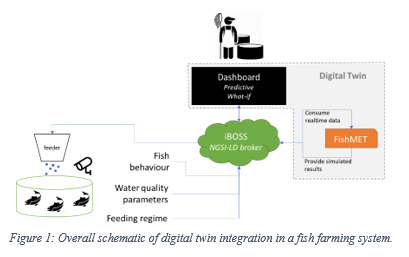USING DIGITAL TWIN FOR DECISION SUPPORT IN RAS FEEDING PROCESSES
Introduction
F or aquaculture to grow to meet world food demands, more intensive and sustainable farming practices must be implemented . This requires developing more effective ways to monitor and control the factors that influence fish health and welfare and to i dentify more efficient and sustainable ways of feeding fish. This reduces pressure on source ingredients, such as agricultural crops and wild-caught fish. M ore intensive aquaculture production requires greater control and monitoring to reduce mortality. This can be achieved through integrating a) optimisation of feeding regimes, b) observation of fish behaviour, and c) expansion of the use of sensory technology to measure water quality . Farmers will have greater and more precise information when it comes to decision making, which will reduce stress and increase overall fish health and welfare. The ambition of iFishIENCi project in which this research is taking place, is to develop and demonstrate disruptive IoT/AI based innovations, considering the feeding value chain a nd addressing commercially important species, with fish quality as focus. Through close collaborations between engineers and fish biologists, the smart feeding and monitoring systems will be more elaborate and precise. New value chains will be identified for the valorisation of specific waste from different production systems. This cutting-edge research is being combined with a holistic understanding of how new technologies interact with society and stakeholders in terms of economy, politics, social welfare, animal welfare and ethics under an RRI framework.
iBOSS platform
Information about fish behaviour, physiology and their environmental conditions can be collected in real-time from a variety of fish farms, and then securely transferred to a digital representation of a real fish. The digital fish will then send a message back to the monitoring system, which can then either inform the farmer, or make an automated change. The core of the iFishIENCi platform, is named iBOSS, is based on the FIWARE brings a curated framework of open- source software components which can be assembled together and combined with other third-party platform components to build platforms easing the development of smart solutions and smart organizations in multiple application domains: cities, manufacturing, utilities, agrifood , etc. The Digital Twin data representation is built based on information gathered from many different sources, including sensors, cameras, farm information systems and farmers observation. It is constantly maintained and accessible in near real-time . Applications constantly process and analyze this data (not only current values but also the history generated over time) in order to automate certain tasks or bring support to smart decisions by end users.
Digital Twin purpose
The digital twin model is based on understanding the whole fish organism as an adaptive agent, robust, testable biological theory that is implemented in the computer code. This means that the model not only describes a specific aspect of fish nutrition, energetics, growth or behaviour in the form of an equation or system of equations. Instead, the digital twin aims to work as a digital organism simulating the most crucial aspects of physiology, neurobiology and behaviour in a digital environment. The agent can therefore act autonomously, make decisions in response to the internal and external environment with continuous feedbacks at multiple biological levels. This means, for example, that the simulation system aims to predict voluntary behaviour and food intake of the fish. This digital twin for feeding will enable running various scenarios and predict the response including unplanned, emergent and stochastic effects. Such a capacity will provide an indispensable tool for decision support and operational optimization and can be run in the AI-controlled precision fish farm environment of iBOSS .
FishMet model
The fish digital twin model accepts the basic biological parameters of the fish as input, such as body size, energetic characteristics, and is built on experiments and literature-based parameters of fish physiology. Environmental inputs include the physical characteristics of the feed, feeding schedule, ambient temperature, oxygen level. The model will then output fish appetite, food intake, feed conversion efficiency, waste production and growth. The autonomous agent type of the model also allows to collect additional outputs, such as behavioural patterns, and predict the internal state of the fish, e.g., motivation and stress level, responses to unexpected change of the feed, stochastic environmental perturbations etc. The modular organization of the model allows to simulate a single fish or a large group in an individual-based model. Water quality , environmental data , fish physiology and behaviour data are collected and made available to the FishMET model in real time through the NGSI-LD data broker of the iBOSS . FishMet is a digital simulation of feeding, fish behaviour, physiology, and metabolism, which consists of differential equations that define feed intake, stomach filling, digestion, absorption, retention of nutrients and will be developed to include feeding behaviour and waste production . The FishMet model include new knowledge about physiological factors that affect appetite and feed intake. Intestinal passage and postabsorptive processing are principal elements. A central part of the model focuses on the changes that occur due to variations in feed type, feeding amount and frequency as well as how environmental factors including temperature, oxygen availability and stress (e.g. handling) will affect feeding behaviour and processes leading to growth. The software engineering work aims to produce a highly modular and customizable system that can run as a separate application and be embedded into the larger decision-support and intelligent fish farm control system iBOSS (
). Specific experiments that will provide appropriate datasets to the modelling activities are currently being performed. In addition to environmental data, individual and shoal behaviour, such as swimming speed and direction, will be monitored with cameras detecting individually marked fish before, during, and after feeding. The fish will also be fed a diet containing a marker to allow correlations between gut transit and feeding behaviour.
